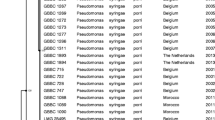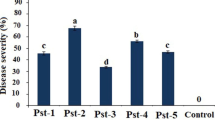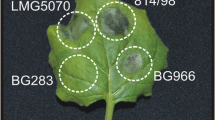Abstract
A repetitive sequence-based (rep)-polymerase chain reaction (PCR) and inter-simple sequence repeat (ISSR)-PCR were used to molecular type Pseudomonas syringae pv. syringae (PSS) strains isolated from barley and wheat plants with bacterial black node symptoms grown in 22 different locations and six different seed-production districts in Japan. Eighteen genomic fingerprinting (GF) genotypes were obtained from the combined results of BOX-, REP-, and GTG5-PCR, indicating that the PSS population in Japan has high genetic diversity. The result based on logistic regression indicated that the population of GF genotype A was significantly related to a seed-producing district and that the epidemic of PSS strains in fields originated mainly from seed infection. This study will be applicable to future studies of the molecular epidemiology of bacterial plant diseases that have multiple infection routes.

Similar content being viewed by others
References
Akaike H (1973) Information theory and an extension of the maximum likelihood principle. In: Petrov BN, Caski F (eds) Proceedings of the 2nd International Symposium on Information Theory, Akadimiai Kiado, Budapest, Hungary, pp 267–281
Alves A, Henriques I, Fragoerio S, Santos C, Phillips AJL, Correia A (2004) Applicability of rep-PCR genomic fingerprinting to molecular discrimination of members of the genera Phaeoacremonium and Phaeomoniella. Plant Pathol 53:629–634
Bonas U (1994) Hrp genes of phytopathogenic bacteria. In: Dangl JL (ed) Bacterial pathogenesis of plants and animals. Springer, Berlin, pp 79–98
Braun-Kiewnick A, Jacobsen BJ, Sands DC (2000) Biological control of Pseudomonas syringae pv. syringae, the causal agent of basal kernel blight of barley, by antagonistic Pantoea agglomerans. Phytopathology 90:368–375
Bull CT, De Boer SH, Denny TP, Firrao G, Ficher-Le Saux M, Saddler GS, Scortichini M, Stead DE, Takikawa Y (2010) Comprehensive list of names of plant pathogenic bacteria, 1980–2007. J Plant Pathol 92:551–592
Çepni E, Gürel F (2012) Variation in extragenic repetitive DNA sequences in Pseudomonas syringae and potential use of modified REP primers in the identification of closely related isolates. Genet Mol Biol 35:650–656
Fukuda T, Azegami K, Tabei H (1990) Studies on bacterial black node of barley and wheat caused by Pseudomonas syringae pv. japonica. Ann Phytopath Soc Jpn 56:252–256 (Japanese with English summary)
Goto K, Nakanishi I (1951) Ear burn, a new bacterial disease of barley (in Japanese with English summary). Ann Phytopath Soc Jpn 15:117–120
Hulton CS, Higgins CF, Sharp PM (1991) ERIC sequences: a novel family of repetitive elements in the genomes of Escherichia coli, Salmonella typhimurium and other enterobacteria. Mol Microbiol 5:825–834
Inoue Y, Takikawa Y (2006) The hrpZ and hrpA genes are variable, and useful for grouping Pseudomonas syringae bacteria. J Gen Plant Pathol 72:26–33
Kaluzna M, Ferrante P, Sobiczewski P, Scortichini M (2010) Characterization and genetic diversity of Pseudomonas syringae from stone fruits and hazelnut using repetitive-PCR and MLST. J Plant Pathol 92:781–787
Kanda Y (2013) Investigation of the freely available easy-to-use software ‘EZR’ for medical statistics. Bone Marrow Transplant 48:452–458
Kawaguchi A (2013) PCR-RFLP identifies differences in hrpZ sequences to distinguish two genetic groups of Pseudomonas syringae pv. syringae strains from barley and wheat with bacterial black node. J Gen Plant Pathol 79:51–55
Kawaguchi A (2014a) Genetic diversity of Xanthomonas arboricola pv. pruni strains in Japan revealed by DNA fingerprinting. J Gen Plant Pathol 80:366–369
Kawaguchi A (2014b) Risk factors for bacterial spot on peach in Okayama Prefecture, Japan. J Gen Plant Pathol 80:435–442
Kawaguchi A, Tanina K (2014) Genetic groups of Clavibacter michiganensis subsp. michiganensis identified by DNA fingerprinting and the effects of inoculation methods on disease development. Euro J Plant Pathol 140:399–406
Mukoo H (1955) On the bacterial black node of barley and wheat and its causal bacteria. Jubilee Publication in Commemoration of the Sixtieth Birthdays of Prof. Yoshihito Tochinai and Prof. Taikishi Fukushi, Publication Society of Jubilee Publication in Commemoration of the Sixtieth Birthdays of Prof. Yoshihiko Tochinai and Prof. Teikichi Fukushi, Sapporo, Japan pp 153–157 (in Japanese)
Oba S, Saito S, Sato M, Ishigaki H, Tanaka T, Uzuki T (1990) On the occurrence of bacterial black node of wheat in Shonai Region of Yamagata Prefecture. Ann Rep Soc Plant Prot North Jpn 41:50–52 (Japanese)
Tamura K, Stecher G, Peterson D, Filipski A, Kumar S (2013) MEGA6: Molecular evolutionary genetics analysis version 6.0. Mol Biol Evol Int J org Evol 30:2725–2729
Versalovic J, Schneider M, de Bruijn FJ, Lupski JR (1994) Genomic fingerprinting of bacteria using repetitive sequence-based polymerase chain reaction. Meth. Mol Cell Biol 5:25–40
Yamashiro M, Waki T, Morishima M, Fukuda T (2011) Occurrence of barley bacterial black node (Pseudomonas syringae pv. japonica) in Tochigi Prefecture and its control by barley seed disinfection treatments. Ann Rep Kanto-Tosan Plant Prot Soc 58:9–12 (Japanese)
Acknowledgements
We thank Mses. M. Senoo and H. Suenaga-Kanetani (Research Institute for Agriculture, Okayama Prefectural Technology Center for Agriculture, Forestry and Fisheries), who supplied some of PSS strains used in this study.
Author information
Authors and Affiliations
Corresponding author
Rights and permissions
About this article
Cite this article
Kawaguchi, A., Tanina, K. & Takehara, T. Molecular epidemiology of Pseudomonas syringae pv. syringae strains isolated from barley and wheat infected with bacterial black node. J Gen Plant Pathol 83, 162–168 (2017). https://doi.org/10.1007/s10327-017-0704-0
Received:
Accepted:
Published:
Issue Date:
DOI: https://doi.org/10.1007/s10327-017-0704-0




